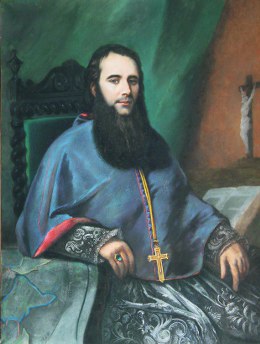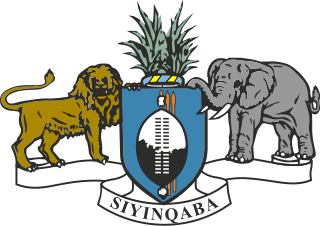
Eswatini, officially the Kingdom of Eswatini and also known by its former official name Swaziland, is a landlocked country in Southern Africa. It is bordered by Mozambique to its northeast and South Africa to its north, west, south, and southeast. At no more than 200 km (120 mi) north to south and 130 km (81 mi) east to west, Eswatini is one of the smallest countries in Africa; despite this, its climate and topography are diverse, ranging from a cool and mountainous highveld to a hot and dry lowveld.

Mbabane is a city in Eswatini, and is one of the two capitals, serving as the executive capital.

Mswati III is Ngwenyama (King) of Eswatini and head of the Swazi royal family.

Lobamba is a city in Eswatini, and is one of the two capitals, serving as the legislative, traditional, spiritual, seat of government of the Parliament of Eswatini, and Ludzidzini Royal Village, the residence of Queen Ntfombi, the Queen Mother.

Manzini is a large city in Eswatini (Swaziland), which is also the capital of Eswatini's Manzini Region. The city is the country's second largest urban center behind the capital Mbabane, with a population of 110,000 (2008). It is known as "The Hub" of Eswatini and lies on the MR3 road. Eswatini's primary industrial site at Matsapha lies near the town's western border.

Cathedral School is a school established and administered by the Catholic Diocese of Lucknow, India, a religious and charitable society engaged in educational, medical and social work in eight districts of Lucknow. It is registered under the Registration of Societies Act No. XXI of 1860. The school is situated in the centre of Hazratganj. It is an unaided, co-educational, institution. A new system Of CCE is also implemented in the school for a continuous and a comprehensive evaluation of students. EduCom Smart Classes are also launched in primary classes of the school.
Inkamana High School is in Vryheid, Kwazulu Natal, South Africa. It was started in 1923 and had 200 boarding students in 2009.

St Peter's Catholic School, colloquially known as St Peter's, is a co-educational secondary school and sixth form located in Guildford, Surrey, England. It is a Roman Catholic school affiliated to the Diocese of Arundel and Brighton.
Pope John Paul II created the Diocese of Kannur in the Ecclesiastical Province of Verapoly in India by bifurcating the Diocese of Calicut on 9 December 1998. The diocese consists of the Latin Catholics of Malabar residing in the revenue districts of Kannur and Kasaragod.

The Society of African Missions, also known as the SMA Fathers, is a Catholic religious society of apostolic life of pontifical right for men founded by Melchior de Marion Brésillac in 1856. They serve the people of Africa and those of African descent.

Christianity is the predominant religion in Eswatini, with Protestantism being its largest denomination.
Education in Eswatini includes pre-school, primary, secondary and high schools, for general education and training (GET), and universities and colleges at tertiary level.
HIV/AIDS in Eswatini was first reported in 1986 but has since reached epidemic proportions. As of 2016, Eswatini had the highest prevalence of HIV among adults aged 15 to 49 in the world (27.2%).

The Roman Catholic Diocese of Maliana is a diocese of the Roman Catholic Church in East Timor and a suffragan diocese of the Archdiocese of Díli. The diocese includes the administrative region of Maliana in districts of Liquica, Bobonaro, and Cova–Lima and 16 sub-districts.
The Swaziland United Democratic Front is a coalition of pro-democracy interests including political parties, unions and churches. The Swaziland United Democratic Front was formed on 2 February 2008 at the Tum's George Hotel in Manzini, Swaziland, attended by 120 persons from various organizations but mainly from the following:

Eswatini, Africa's last remaining absolute monarchy, was rated by Freedom House from 1972 to 1992 as "Partly Free"; since 1993, it has been considered "Not Free". During these years the country's Freedom House rating for "Political Rights" has slipped from 4 to 7, and "Civil Liberties" from 2 to 5. Political parties have been banned in Eswatini since 1973. A 2011 Human Rights Watch report described the country as being "in the midst of a serious crisis of governance", noting that "[y]ears of extravagant expenditure by the royal family, fiscal indiscipline, and government corruption have left the country on the brink of economic disaster". In 2012, the African Commission on Human and Peoples' Rights (ACHPR) issued a sharp criticism of Eswatini's human-rights record, calling on the Swazi government to honor its commitments under international law in regards to freedom of expression, association, and assembly. HRW notes that owing to a 40% unemployment rate and low wages that oblige 80% of Swazis to live on less than US$2 a day, the government has been under "increasing pressure from civil society activists and trade unionists to implement economic reforms and open up the space for civil and political activism" and that dozens of arrests have taken place "during protests against the government's poor governance and human rights record".

In Eswatini, no king can appoint his successor. Instead, the Liqoqo, an independent traditional council, decides which of the wives shall be "Great Wife" and "Indlovukazi". The son of this "Great Wife" will automatically become the next king.

St. George Forane Church Kallody is situated in Mananthavady taluk of Wayanad district. It is one of the important churches and pilgrim centers in the region, in communion with the Syro-Malabar Catholic Church.
The Mater Dolorosa Church or just Mater Dolorosa Parish, is a Catholic church located in the city of Mbabane, Eswatini (Swaziland). It is adjacent to a secondary and elementary school of the same name.

Nothando Hlophe is a Swazi gospel singer and royal. She was a member of the gospel and worship musical group Women in Praise until she broke out as a solo artist, releasing her debut solo album in 2016. In 2019, Hlophe won Female Artist of the Year, Best Gospel Artist, and Song of the Year at the 3rd Annual MTN SWAMA Awards. From 2019 to 2022, she took a hiatus from her music career. During her hiatus, she married Prince Majahonkhe Dlamini, a son of Mswati III, becoming a member of the Swazi royal family with the title Inkhosikati LaHlophe. Hlophe returned to performing in 2022 with the launch of a live album and a performance at The Great Revival in Mbabane.












